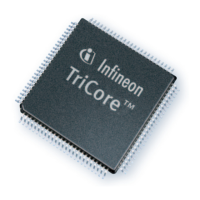TriCore
®
TC1.6P & TC1.6E
32-bit Unified Processor Core
Instruction Set Overview
V1.0 2013-07
User Manual (Volume 2) 2-23
2.12.3 Access to the Core Special Function Registers (CSFRs)
The core accesses the CSFRs through two instructions:
•MFCR
– The Move From Core Register instruction moves the contents of the addressed CSFR into a data register.
MFCR can be executed in any mode (i.e. User-1, User-0 or Supervisor mode).
•MTCR
– The Move To Core Register instruction moves the contents of a data register to the addressed CSFR. To
prevent unauthorized writes to the CSFRs the MTCR instruction can only be executed in Supervisor mode.
An MTCR instruction should be followed by an ISYNC instruction. This ensures that all instructions following
the MTCR see the effects of the CSFR update.
There are no instructions allowing bit, bit-field or load-modify-store accesses to the CSFRs. The RSTV instruction
(Reset Overflow Flags) only resets the overflow flags in the PSW without modifying any of the other PSW bits.
This instruction can be executed in any mode (i.e. User-1, User-0 or Supervisor mode).
The CSFRs are also mapped into the memory address space. This mapping makes the complete architectural
state of the core visible in the address map, which allows efficient debug and emulator support. Note that it is not
permitted for the core to access the CSFRs through this mechanism. The core must use MFCR and MTCR.
Figure 2-18 summarizes TriCore core behaviour when accessing CSFRs.
Figure 2-18 TriCore, Core Behaviour Accessing CSFRs
2.12.4 Enabling and Disabling the Interrupt System
For non-interruptible operations, the ENABLE and DISABLE instructions allow the explicit enabling and disabling
of interrupts in both User and Supervisor mode. While disabled, an interrupt will not be taken by the CPU
regardless of the relative priorities of the CPU and the highest interrupt pending. The only ‘interrupt’ that is serviced
while interrupts are disabled is the NMI (Non-Maskable Interrupt), because it bypasses the normal interrupt
structure.
If a user process accidentally disables interrupts for longer than a specified time, watchdog timers can be used to
recover.
TC1062B
Read CSFR
MFCR Da, CSFR_addr
Is CSFR_addr Word
aligned ?
Unimplemented
Register ?
Write CSFR
MFCR CSFR_addr, Da
Supervisor Mode ?
Is CSFR_addr Word
aligned ?
Is register read-only ?
Unimplemented
Register ?
No
No
Yes
Yes
Return
undefined value
Da = CSFR
Privilege trap
No effect
No effect
No effect
No
CSFR = Da
No
Yes
Yes
No
No
Yes
Yes
Return
undefined value

